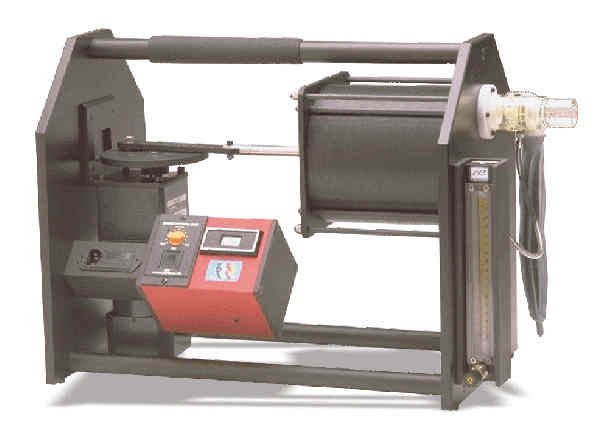Search by Catalog Number













VacuMed
4125 Market St #10
Ventura, CA 93003
(800) 235-3333
|
Motorized Calibration Syringes with optional Metabolic Simulator Kits
Essentially a lung simulator. Metabolic calibration kits create known VO2 & VCO2.
Most flow sensors are typically calibrated with a fixed volume manual syringe, but little is known about the performance of that flow sensor over the whole physiological range, typically 6 to 60 breaths per minute. So how does this affect the accuracy of your ventilation measurements (and ultimately VO2) when you have calibrated the flow sensor at some unknown manual stroke speed, then use the sensor for low-flow pediatric or resting measurements, or high flow VO2 max measurements?
Specifications for Syringe models 17050-2, 17050-3, -4
Rate (stroke) Accuracy: +/- 0.2 Motor speed is continuously variable from approx. 6 to 80 strokes per minute. Digital Display: Breaths per minute Stroke Volume (Preset stops) Fpr model 17050-2: 0.5, 0.75, 1.0, 1.5 and 2.0 For model 17050-3: 0.5, 1.0, 1.5, 2.0, 2.5, and 3.0 liters For model 17050-4: 1.0, 2.0, 3.0 and 4.0 liters (Other volume settings available on special order) Size: 12" (31cm) wide x 16.5" (43cm) high x 31" (77cm) long. Add 3" length for Metabolic Calibration Kit. Voltage: 110 / 220 VAC (Specify) Weight: Approx 40 pounds Models 17050-3 and 17050-4 with the 17051A or 17054 option can only be used for CPX systems that utilize expired ventilation measures for the VO2 calculation (most systems).
Model 17051A requires manual flow adjustment of the metabolic gas mixture using a pre-calibrated rotameter as shown in above photo.
In model 17054 the rotameter is replaced be a mass flow meter with digital mass flow display.
The provided O2CAL.xls spreadsheet software enable precise determination of the selected metabolic rate and the percentage error of the metabolic measurement system being calibrated.
Why Metabolic Calibration?
Most manufacturers
make grandiose claims about the accuracy of their gas
analyzers. The advertised specifications are often difficult to understand,
if they claim 0.01% accuracy, just what does it mean, 0.01% of what? But
let's not quibble about details
So what claims are
being made for the accuracy of VE measurements?
No mention is
made of the accuracy of the VE measurement. If the accuracy is in fact
specified, does it hold true over the whole metabolic range, i.e. from,
say, 6 to 80 breaths per minute? Will the accuracy be maintained during
and after a CPX test?
What about the accuracy of your VO2 and VCO2 measurements? Do you really know? Do you trust the measurement because the manufacturer is a well-known company? Or did you compare it to the Douglas bag method? Perhaps you compared it to another so-called "well-known" system. Say you are using your CPX system to track the progress of athletes in a training program or to track improvement of patients undergoing rehabilitation. You, the athlete and his or her trainer want to know changes in the Lactate/Anaerobic Threshold and VO2 max as the training program progresses. Now we ask, what good is a CPX system with an accuracy of 10%? (Some systems are worse than that at maximum exercise!) Only Metabolic Calibration can check the accuracy of your CPX system.
Our model 17051A or 17054 options for metabolic calibration make the above mentioned motorized syringe pump into a very accurate Metabolic Calibrator/Simulator.
Metabolic Calibration uses the principle of mass preservation to create known VO2 and VCO2. The principle of mass preservation dictates that the chosen mass flow of CO2 and O2 remains unchanged regardless of the ventilatory dilution (i.e. the minute ventilation that delivers it into the system under calibration).
Order option 17051A or 17054 separately.
A Metabolic Calibration gas containing 20.9% CO2, balance N2, is required. The calibration kits include an Excel file that allows you to make the required BTPS/STPD corrections automatically and print a calibration report. If you want to read more about Metabolic Calibration, click on "Dr. Andrew's Corner" and check out references 1 and 2. References: 1. HUSZCZUK, A., B.J. WHIPP, and K. WASSERMAN. A respiratory gas exchange simulator for routine calibration in metabolic studies. Eur. Respir. J. 3:465-468, 1990 2. GORE, C.J.,
P.G. CATCHESIDE, S.N. FRENCH, J.M. BENNETT, and J. LAFORGIA. Automated
VO2 max calibrator for open-circuit indirect calorimetry systems. Med.Sci.
Sports Exerc 29:1095-1103, 1997
Software 17051-2 is included at no additional cost when you purchase 17051A, 17051-1, 17052 or 17054.
We also offer Metabolic Calibration of any Metabolic Measurement System in your lab.
|